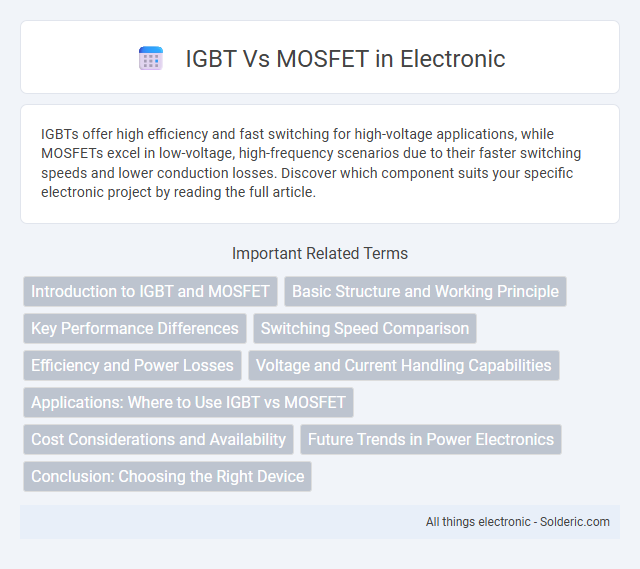IGBTs offer high efficiency and fast switching for high-voltage applications, while MOSFETs excel in low-voltage, high-frequency scenarios due to their faster switching speeds and lower conduction losses. Discover which component suits your specific electronic project by reading the full article.
Comparison Table
| Parameter | IGBT (Insulated Gate Bipolar Transistor) | MOSFET (Metal-Oxide-Semiconductor Field-Effect Transistor) |
|---|---|---|
| Switching Speed | Moderate (microseconds range) | High (nanoseconds range) |
| Voltage Rating | High (600V to 1700V+) | Medium to High (30V to 600V) |
| Current Handling | High current capability | Moderate to high current |
| Conduction Loss | Lower at high voltages | Lower at low voltages |
| Gate Drive Voltage | 15V typically | 5-10V typically |
| Thermal Performance | Better for high power | Good but limited at high power |
| Applications | Motor drives, inverters, high voltage switching | Low voltage DC-DC converters, RF amplifiers, switching power supplies |
| Cost | Generally higher | Generally lower |
Introduction to IGBT and MOSFET
IGBT (Insulated Gate Bipolar Transistor) and MOSFET (Metal-Oxide-Semiconductor Field-Effect Transistor) are essential semiconductor devices used in power electronics for switching and amplification. IGBTs combine the high input impedance of MOSFETs with the low on-state power loss of bipolar transistors, making them ideal for high voltage and high current applications. Your choice between IGBT and MOSFET depends on factors like switching frequency, voltage rating, and efficiency requirements.
Basic Structure and Working Principle
IGBT (Insulated Gate Bipolar Transistor) combines the MOSFET's gate structure with the bipolar transistor's high-current capability, featuring a four-layer (PNPN) structure that allows voltage control and high efficiency in switching applications. MOSFET (Metal-Oxide-Semiconductor Field-Effect Transistor) operates through a three-layer structure (source, drain, and gate) using voltage to create a conductive channel, enabling fast switching and low on-resistance. Both devices control current flow via gate voltage but differ in internal architecture, making IGBT preferable for high-voltage, high-current scenarios and MOSFET ideal for high-speed, low-voltage operations.
Key Performance Differences
IGBTs offer higher voltage and current ratings, making them ideal for high-power applications such as motor drives and inverters, whereas MOSFETs excel in low-voltage, high-speed switching scenarios due to their faster switching times and lower conduction losses. Your choice between IGBT and MOSFET depends on the specific performance requirements, including switching frequency, voltage, and efficiency. MOSFETs provide better thermal performance and efficiency at high frequencies, while IGBTs handle higher voltages with robustness but suffer from slower switching speeds.
Switching Speed Comparison
IGBTs generally exhibit slower switching speeds compared to MOSFETs due to their bipolar conduction mechanism, making MOSFETs more suitable for high-frequency applications. MOSFETs switch efficiently in the range of nanoseconds, enabling faster response times and reduced switching losses. Your choice between IGBT and MOSFET should consider the required switching speed and frequency for optimal performance in power electronics.
Efficiency and Power Losses
IGBTs typically exhibit lower conduction losses at high voltages, making them more efficient for switching heavy loads above 600V. MOSFETs offer faster switching speeds and lower switching losses at lower voltages, enhancing their efficiency in applications below 250V. The choice between IGBT and MOSFET substantially impacts overall system efficiency and power losses, with IGBTs favored for high-voltage, high-current use cases and MOSFETs preferred for low-voltage, high-frequency operations.
Voltage and Current Handling Capabilities
IGBTs excel in high voltage applications, typically handling voltages above 600V, making them suitable for industrial motor drives and power inverters requiring efficient switching at high power levels. MOSFETs are preferred in low to medium voltage ranges, usually below 250V, offering faster switching speeds and lower conduction losses ideal for fast-switching circuits and low-voltage power supplies. The current handling capability of IGBTs is superior for high-power scenarios, whereas MOSFETs provide efficient current conduction in compact, low-power designs.
Applications: Where to Use IGBT vs MOSFET
IGBTs are ideal for high-voltage, high-current applications such as industrial motor drives, electric vehicle inverters, and renewable energy systems due to their superior switching capabilities at voltages above 600V. MOSFETs excel in low-voltage, high-speed switching environments like computer power supplies, DC-DC converters, and audio amplifiers because of their fast switching times and low on-resistance. Selecting between IGBT and MOSFET depends on voltage level, switching frequency, and efficiency requirements specific to each application.
Cost Considerations and Availability
IGBTs generally cost more than MOSFETs due to their complex structure and higher voltage handling capabilities, making MOSFETs a more economical choice for low-voltage applications. Availability tends to favor MOSFETs as they are widely produced and used across various industries, ensuring easier sourcing and lower lead times. Your decision should weigh the balance between cost efficiency and performance requirements, with MOSFETs preferred for cost-sensitive, low-voltage needs and IGBTs for high-power, industrial uses.
Future Trends in Power Electronics
Future trends in power electronics emphasize the evolving roles of IGBT and MOSFET technologies, with MOSFETs increasingly favored for high-frequency, low-voltage applications due to their faster switching and higher efficiency. IGBTs continue to dominate high-voltage, high-current scenarios, benefiting from advancements in silicon carbide (SiC) and gallium nitride (GaN) materials that enhance thermal performance and switching speeds. Your choice between IGBT and MOSFET will depend on the specific requirements of emerging applications such as electric vehicles, renewable energy systems, and smart grids, where power density and efficiency are critical.
Conclusion: Choosing the Right Device
Choosing between IGBT and MOSFET depends on your application's voltage, current, and switching frequency requirements. IGBTs are ideal for high-voltage, high-current applications with moderate switching speeds, commonly used in industrial motor drives and power inverters. MOSFETs excel in low-voltage, high-frequency switching scenarios like power supplies and RF amplifiers, offering faster switching and greater efficiency at lower power levels.
IGBT vs MOSFET Infographic

 solderic.com
solderic.com